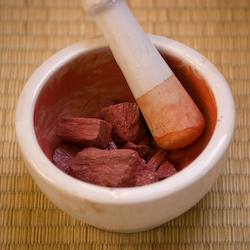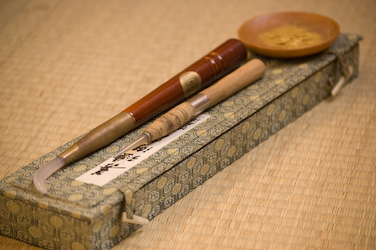What is a thangka?
 A thangka is literally a scroll painting. It functions primarily as a physical representation or embodiment of enlightened body, speech and mind. They can be teaching aids or illustrate medical or astrological subject matter, geometric mandalas (highly precise circular diagrams of the universe), stupas (reliquaries, originally funerary mounds, representing awakened mind), etc. Most commonly however, they are used in conjunction with sadhanas (means of accomplishment, practice liturgy), which layout very specific details concerning the attributes of certain deities as they are to be visualized by someone who has been introduced or initiated into that practice. The primary figures that one would find represented are: teachers (great masters or lineage patriarchs), yidams (a personal meditational deity), buddhas (those that have realized the true nature of reality and continually abide in that experience), bodhisattvas (those that have realized their true nature but postpone their own complete awakening until all sentient beings have reached that level of realization), dakinis and dakas (female and male expressions of dynamic inspiration and non conceptual wisdom, “sky goers”; they are known as the root of activity because through clearing away obstacles they create the conditions for practice and realization), dharmapalas (compassionate protectors of the dharma most often depicted with very intense, wrathful attributes; they are for the most part, demon-like beings that have been tamed by great masters to remove obstacles and protect the best interests of the dharma), yakshas (male and female nature spirits from India which have been absorbed and transformed into Hinduism and Buddhism), and wealth deities invoked for removing material obstacles to practicing the dharma and other lesser deities.
A thangka is literally a scroll painting. It functions primarily as a physical representation or embodiment of enlightened body, speech and mind. They can be teaching aids or illustrate medical or astrological subject matter, geometric mandalas (highly precise circular diagrams of the universe), stupas (reliquaries, originally funerary mounds, representing awakened mind), etc. Most commonly however, they are used in conjunction with sadhanas (means of accomplishment, practice liturgy), which layout very specific details concerning the attributes of certain deities as they are to be visualized by someone who has been introduced or initiated into that practice. The primary figures that one would find represented are: teachers (great masters or lineage patriarchs), yidams (a personal meditational deity), buddhas (those that have realized the true nature of reality and continually abide in that experience), bodhisattvas (those that have realized their true nature but postpone their own complete awakening until all sentient beings have reached that level of realization), dakinis and dakas (female and male expressions of dynamic inspiration and non conceptual wisdom, “sky goers”; they are known as the root of activity because through clearing away obstacles they create the conditions for practice and realization), dharmapalas (compassionate protectors of the dharma most often depicted with very intense, wrathful attributes; they are for the most part, demon-like beings that have been tamed by great masters to remove obstacles and protect the best interests of the dharma), yakshas (male and female nature spirits from India which have been absorbed and transformed into Hinduism and Buddhism), and wealth deities invoked for removing material obstacles to practicing the dharma and other lesser deities.
The approach to painting a thangka is done with the same motivation and intention as with sadhana practice or carrying the practice in every moment of one’s life for that matter. Ideally one rests in the nature of experience while allowing the process of creation to unfold. Manifesting a thangka takes a considerable amount of time to accomplish and involves an intimate knowledge of the subject matter. Often, high lamas are consulted when there is uncertainty about lesser known practices as it is important for there to be consistency between the practice liturgy and the painting to avoid confusion.
Deities in the Tantric view
“In one sense they [deities] exist as a method to undermine our pathetic projection of ourselves and our universe as flawed, a way of connecting with our true human/buddha nature. At the same time, they are that nature. They represent an alternate reality that more precisely reflects the innate purity of our minds. They are forms that display the immanence of buddha nature in everything. All the different ways of relating with deities are ways we already have of relating to our experience. In this sense, the practice of deity meditation is a skillful way of undermining our ordinary mistaken sense of solid reality and moving closer to a true mode of perception. By creatively using forms that recall innate purity, the habitual mistake of relating to thoughts and emotions as other than pure is reversed. It is taught that the practice of visualizing deities plants the seed for our later manifestation of form bodies for the benefit of beings at the time of enlightenment. This is why the seemingly simple approach of directly apprehending the empty radiant nature of mind is not enough. The body of reality alone would be the result of that apprehension. But that would be, in a sense, emptiness without form, and would accomplish only one’s own purpose. The body of reality must be accessible somehow to sentient beings in whom it is still hidden. That is the natural function of the form manifestations. It is still necessary to work with the whole phenomenal world, form and emptiness inseparable.”
Sarah Harding
The primary steps involved
1. Preparing the canvas which is usually made of a fine woven cotton, stretched onto an inner frame and then fastened to an outer frame with braided cord. This would allow the tautness of the painting to be adjusted.
2. Preparing the gesso and adding mendrup (blessing pills made from medicinal herbs and relics ground into a powder). Then applying it in layers, either polishing each subsequent layer of gesso with a flat piece of marble or a smooth oval shaped stone or lightly sanding it with sandpaper to remove any debris or raised surfaces. There are different materials and techniques for doing this depending on the teacher and/or school.
3. Making the drawing, which, for all except great masters, involves using a proportional grid specific to each class of deity. The very specific measurements and proportions (Tig say) of these figures has been handed down through the centuries, primarily from Indian tantras such as the Kalachakra Tantra, Samvarodaya Tantra, Krishnayamari Tantra and the Manjusrimulakalpa Tantra. The main classes of distinct proportion relate to buddhas, peaceful bodhisattvas, goddesses, tall wrathful figures, short wrathful figures and humans.
4. After the drawing is completed, a wash of “tea stain” is applied to the canvas in some traditions. Then the drawing is transferred to the canvas by various means. Some methods include, tracing the image using a light source, pouncing a stencil with colored powder and redrawing the lines or completely drawing the original on the canvas. Some painters then ink the drawing so the lines don’t fade from rubbing.
 5. Next, the painter in some traditions would paint the border of the painting red, but in other traditions this step was reserved until the painting was complete, thereby empowering it’s presence.
5. Next, the painter in some traditions would paint the border of the painting red, but in other traditions this step was reserved until the painting was complete, thereby empowering it’s presence.
6. At this point the application of color started from the furthest landscape elements (sky and clouds) to the closest (mountains and water). Traditionally sky was painted using finely ground azurite, a practice that continues today, but many contemporary painters choose to use indigo guache instead. This is the most time consuming part of the whole painting. Basically, one is applying tiny dots of diluted pigment, layer upon layer for weeks, months or years to create the desired gradation.
7. After all landscape elements have been completed and their pure realm awaits them, the deities are painted. Generally all flat colors are applied first, then outlines, then shading. Some teachers recommend doing the shading first and then outlining.
8. Real Gold is then applied to jewelry, luminous rays of light, brocade patterns, etc. and then burnished either in solid areas or in patterns with an agate burnisher to create a 3 dimensional appearance. Gold is considered very highly in terms of offerings. It’s unique quality of being a mirror-like reflection of one’s own innate brilliance and purity make it an indispensable addition to a thangka.
9. Finally, the eyes of all figures are completed. This awakens them and imbues the painting with a life force.
10. At this point it is mounted into a brocade.
11. Before it is used in formal practice, there is a blessing and consecration ritual performed by a lama. Often this includes painting the syllables of enlightened body, speech and mind (OM, AH, and HUNG) on the reverse side of the painting at the corresponding points of crown, throat and heart of each deity.

